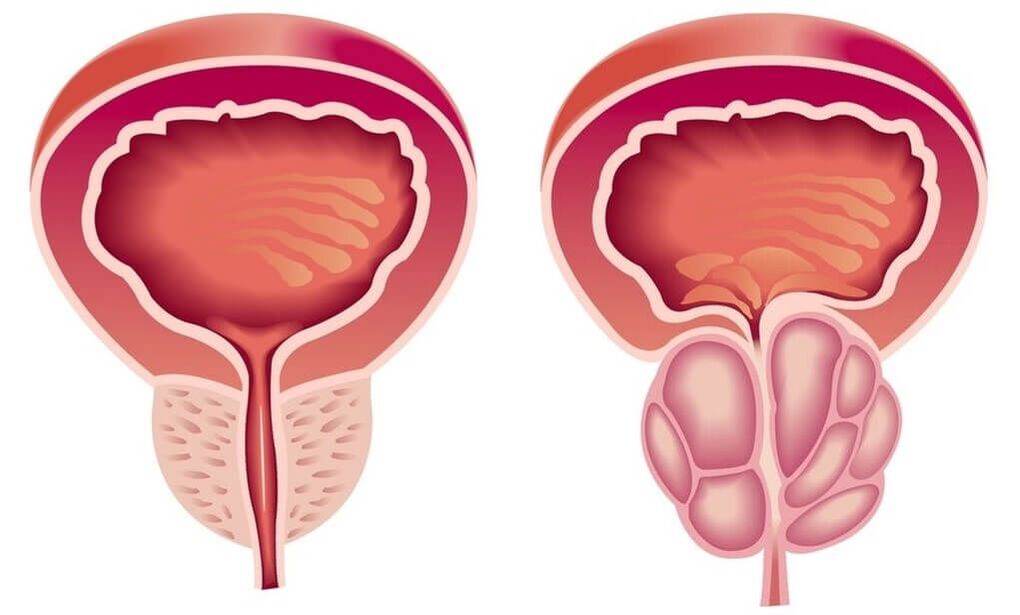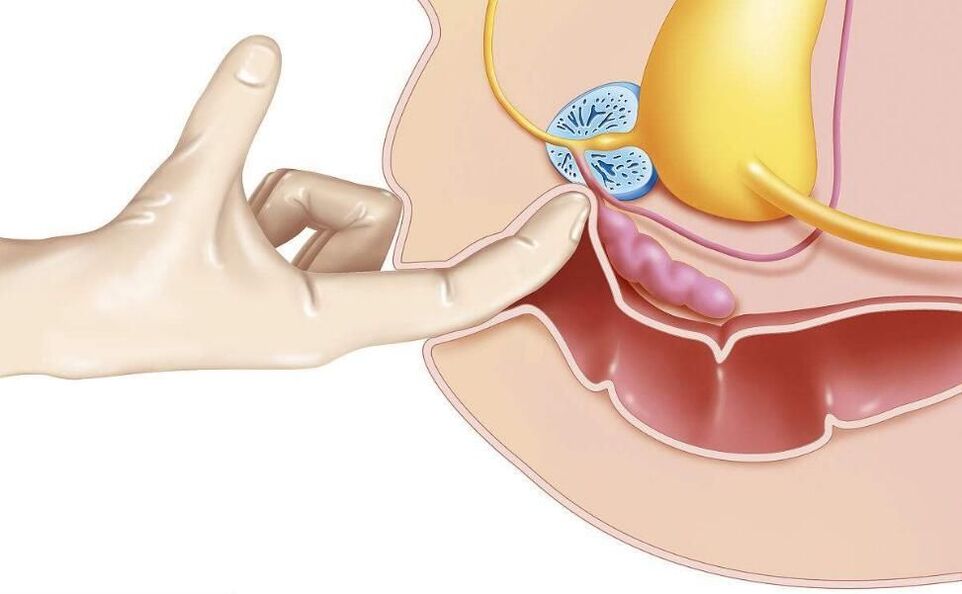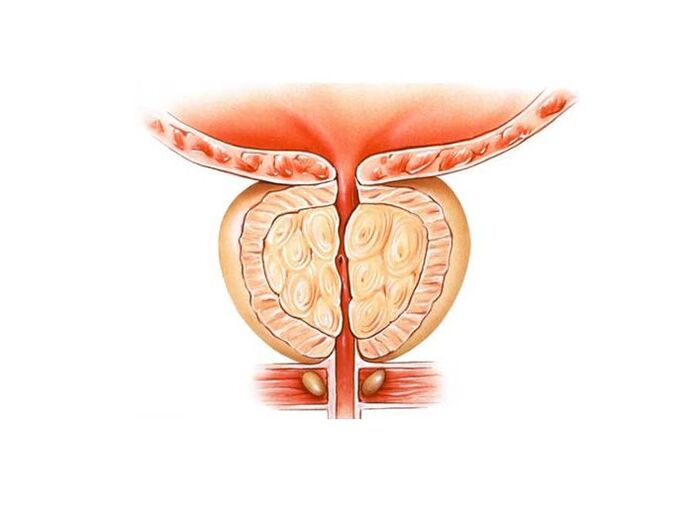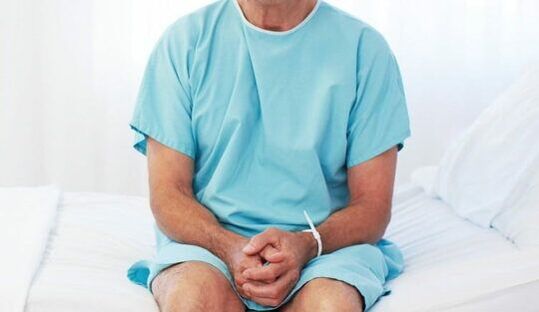Prostatitisinflammatory disease of the prostate. Frequent urination, pain in the penis, scrotum, rectum, sexual disorders (erectile dysfunction, premature ejaculation, etc. ), sometimes urinary retention, blood in the urine. The diagnosis of prostatitis is established by a urologist or andrologist based on a typical clinical picture and the results of a rectal examination. In addition, they perform an ultrasound of the prostate, prostate secretions and urine. The treatment is conservative - antibiotic therapy, immunotherapy, prostate massage, lifestyle correction.

general information
Prostatitis is inflammation of the seminal (prostate) gland - the prostate. It is the most common disease of the urinary system in men. It most often affects patients aged 25-50. According to various data, 30-85% of men over the age of 30 suffer from prostatitis. It is possible to develop a prostate abscess, inflammation of the testicles and appendages, which threatens infertility. The rise of the infection leads to inflammation of the upper urinary tract (cystitis, pyelonephritis).
The pathology develops when an infectious agent enters the prostate tissue from the organs of the urogenital system (urethra, bladder) or from a distant inflammatory focus (pneumonia, influenza, tonsillitis, furunculosis).

Causes of prostatitis
As infectious agents in the acute process, Staphylococcus aureus (Staphylococcus aureus), Enterococcus (Enterococcus), Enterobacter (Enterobacter), Pseudomonas (Pseudomonas), Proteus (Proteus), Klebsiella (Klebsiella) and Escherichia coli (E. . Amost microorganisms belong to conditionally pathogenic flora and cause prostatitis only in the presence of other predisposing factors. Chronic inflammation is usually caused by polymicrobial associations.
The risk of developing the disease increases with hypothermia, specific infections in the anamnesis, and conditions accompanied by congestion of prostate tissue. There are the following predisposing factors:
- General hypothermia (one-time or permanent, related to working conditions).
- Sedentary lifestyle, a specialty that forces a person to sit for a long time (computer operator, driver, etc. ).
- Constant constipation.
- Violation of the normal rhythm of sexual activity (excessive sexual activity, prolonged abstinence, incomplete ejaculation during "usual" sexual intercourse, without emotional coloring).
- Chronic diseases (cholecystitis, bronchitis) or the presence of chronic infectious foci in the body (chronic osteomyelitis, untreated caries, tonsillitis, etc. ).
- Previous urological diseases (urethritis, cystitis, etc. ) and sexually transmitted diseases (chlamydia, trichomoniasis, gonorrhea).
- Conditions that suppress the immune system (chronic stress, irregular and undernourished, regular lack of sleep, overtraining of athletes).
It can be assumed that the risk of developing pathology increases with chronic intoxication (alcohol, nicotine, morphine). In the field of modern andrology, some studies prove that chronic perineal trauma (vibration, concussion) of motorists, motorcyclists and cyclists is a provoking factor. However, the vast majority of experts believe that all these conditions are not the real causes of the disease, but only contribute to the aggravation of the latent inflammatory process in the tissues of the prostate.
Congestion of prostate tissues plays a decisive role in the occurrence of prostatitis. Violation of capillary blood flow increases lipid peroxidation, edema, secretion of prostate tissues and creates conditions for the development of an infectious process.
Symptoms of prostatitis
Acute prostatitis
There are three stages of acute prostatitis, which are characterized by certain clinical picture and morphological changes:
- Acute catarrhal. Patients complain of frequent, often painful urination, pain in the sacrum and perineum.
- Acute follicular. The pain becomes more intense, sometimes radiating to the anus, which is aggravated by defecation. Urination is difficult, urine comes out in a thin stream. In some cases, there is urinary retention. A typical subfebrile state or moderate hyperthermia.
- Acutely parenchymal. Severe general poisoning, hyperthermia up to 38-40°C, chills. Dysuric disorders, often - acute urinary retention. Sharp, throbbing pains in the perineum. Difficulty passing stool.
Chronic prostatitis
In rare cases, chronic prostatitis will be the result of an acute process, but usually a primary chronic course is observed. The temperature sometimes rises to subfebrile values. The patient notices slight pain in the perineum, discomfort during urination and defecation. The most characteristic symptom is a slight discharge from the urethra during defecation. The primary chronic form of the disease develops over a considerable period of time. It is preceded by prostosis (stagnation of blood in the capillaries), which gradually turns into abacterial prostatitis.
Chronic prostatitis is often a complication of the inflammatory process caused by the causative agent of a particular infection (chlamydia, trichomonas, ureaplasma, gonococcus). In many cases, the symptoms of a specific inflammatory process mask the manifestations of prostate damage. Perhaps a slight increase in pain during urination, a slight pain in the perineum, a slight discharge from the urethra during defecation. A slight change in the clinical picture often goes unnoticed by the patient.
Chronic inflammation of the prostate can manifest itself in a burning sensation in the urethra and perineum, dysuria, sexual disorders, and increased general fatigue. Violation of potency (or fear of it) often results in mental depression, anxiety and irritability. The clinical picture does not always include all the listed symptom groups, it is different in different patients and changes over time. Chronic prostatitis is characterized by three main syndromes: pain, dysuria, and sexual disorders.
There are no pain receptors in prostate tissue. The cause of pain in chronic prostatitis becomes almost inevitable due to the abundant innervation of the pelvic organs and the involvement of nerve pathways in the inflammatory process. Patients complain of pain of varying intensity - from weak, aching to intense, disturbing sleep. The nature of the pain changes (increases or weakens) due to ejaculation, excessive sexual activity or sexual abstinence. Pain radiates to the scrotum, sacrum, perineum, and sometimes to the lumbar region.
As a result of the inflammation that occurs in chronic prostatitis, the volume of the prostate increases, compressing the urethra. The lumen of the ureter decreases. The patient has a frequent urge to urinate, a feeling of incomplete emptying of the bladder. Usually, dysuric phenomena are expressed in the early stages. Then compensatory hypertrophy of the muscle layer of the bladder and ureters develops. The symptoms of dysuria weaken during this period, and then increase again with the decompensation of adaptive mechanisms.
In the initial stage, dyspotency may develop, which manifests itself differently in different patients. Patients may complain of frequent nocturnal erections, blurred orgasms, or worsening erections. Accelerated ejaculation is associated with a decrease in the excitation threshold level of the orgasmic center. Painful sensations during ejaculation can cause refusal of sexual activity. In the future, sexual dysfunctions will become more and more prominent. In an advanced stage, impotence develops.
The degree of sexual dysfunction is determined by many factors, including the sexual constitution and psychological mood of the patient. Violation of potency and dysuria can be caused both by changes in the prostate and by the suggestibility of the patient, who expects the inevitable development of sexual disorders and urinary disorders in the case of chronic prostatitis. Especially often, psychogenic dyspotency and dysuria develop in suggestive, anxious patients.
Impotence and sometimes the danger of possible sexual disorders are difficult for patients to tolerate. Often there is a change in character, irritability, discomfort, excessive concern for one's own health, even "taking care of the disease".
Complications
In the absence of timely treatment of acute prostatitis, there is a significant risk of developing a prostate abscess. With the development of a purulent focus, the patient's body temperature rises to 39-40 ° C and can become hectic. Periods of heat alternate with strong chills. Sharp pains in the perineum make urination difficult and defecation impossible.
An increase in prostatic edema leads to acute urinary retention. Rarely, the abscess ruptures spontaneously into the urethra or rectum. When opened, purulent, cloudy urine with an unpleasant pungent odor appears in the urethra, and when opened, the stool contains pus and mucus in the rectum.
Chronic prostatitis is characterized by an undulating course, with long periods of remission, during which the prostatitis is latent or presents with extremely weak symptoms. Patients who are not bothered by anything often stop treatment and come back only if complications develop.
The spread of the infection through the urinary tract causes the occurrence of pyelonephritis and cystitis. The most common complication of the chronic process is inflammation of the testes and epididymis (epdidymo-orchitis) and inflammation of the seminal vesicles (vesiculitis). The consequence of these diseases is often infertility.
Diagnostics
The characteristic clinical picture simplifies the process of diagnosis in acute and chronic prostatitis. Obligatory:
Treatment of prostatitis
Treatment of acute prostatitis
Patients with an uncomplicated acute process are treated by a urologist on an outpatient basis. Hospital treatment is required in case of suspicion of severe poisoning or purulent process. Antibacterial therapy is performed. The preparations are selected taking into account the sensitivity of the infectious agent. Antibiotics are widely used, which penetrate well into the tissues of the prostate.
In the event of acute urinary retention arising from prostatitis, a cystostomy and not a urethral catheter is used, as there is a risk of prostate abscess formation. With the formation of an abscess, an endoscopic transrectal or transurethral opening of the abscess is performed.
Treatment of chronic prostatitis
Treatment of chronic prostatitis should be complex, including etiotropic therapy, physiotherapy, correction of immunity:
- Antibiotic therapy. The patient is prescribed long antibacterial drugs (within 4-8 weeks). The type and dose of antibacterial drugs and the duration of treatment are determined individually. The drug is selected based on the sensitivity of the microflora, according to the results of urine culture and prostate secretion.
- Prostate massage.Massage of the gland has a complex effect on the affected organ. During the massage, the inflammatory secretion accumulated in the prostate is squeezed out into the channels, then enters the urethra and is excreted from the body. The procedure improves blood circulation in the prostate, which minimizes congestion and ensures better penetration of antibacterial drugs into the tissue of the affected organ.
- Physiotherapy.Laser exposure, ultrasound waves and electromagnetic vibrations are used to improve blood circulation. If it is impossible to perform physiotherapy procedures, the patient is prescribed warm medicinal microclysters.
In the case of chronic, long-lasting inflammation, a consultation with an immunologist is justified to choose the tactics of immune correction therapy. The patient gives advice on lifestyle changes. Certain changes in the lifestyle of patients with chronic prostatitis are both curative and preventive measures. The patient is recommended to normalize sleep and wakefulness, establish a diet, and moderate physical activity.
Antibiotic therapy is the most effective treatment for prostatitis. Phytotherapy, immunocorrectors and hormone preparations can also be used as prescribed by the doctor.
In the absence of acute symptoms, prostatitis can be treated with physiotherapy methods. In case of abscesses and suppurations, surgical intervention is recommended.
Drug treatment
The treatment of prostatitis through antibiotic therapy should be started with bakposev, the purpose of which is to assess the body's sensitivity to this type of antibiotic. In case of violation of urination, the use of anti-inflammatory drugs is a good result.
Medicines are taken in tablets, in acute cases - in the form of droppers or intramuscularly. Rectal suppositories are effective for the treatment of chronic forms of prostatitis: with their help, drugs reach their goal faster and have a minimal effect on other organs.
Blood thinners and anti-inflammatory drugs are also well proven.
Antibacterial therapy
Antibiotics are effective treatments for bacterial prostatitis. In order to achieve the desired effect and harm the body, the selection of the drug, the dosage and the treatment regimen must be carried out by a doctor. In order to correctly choose the most effective drugs, you need to find out which pathogen caused prostatitis and check the patient for tolerance to a certain group of antibiotics.
Antibiotics belonging to the group of fluoroquinolones are well proven in the effective treatment of chronic prostatitis. Their activity is aimed at suppressing bacterial infection and strengthening the body's own immunity. In addition, a bacteriostatic antibiotic is recommended for the prevention and treatment of concomitant diseases of the urogenital system.
Prostatitis caused by mycoplasma and chlamydia can also be treated with macrolide and tetracycline drugs, which slow the spread of the infection.
The duration of taking antibacterial drugs is 2-4 weeks. In case of positive dynamics, the course can be extended.
Physiotherapy
Physiotherapy methods in the treatment of prostatitis are aimed at activating blood circulation in the pelvis, improving the metabolic processes of the prostate gland and cleaning the channels. If physiotherapy is combined with antibiotics, the effect of the latter is enhanced.
The main methods are:
- magnetotherapy;
- laser therapy;
- electrophoresis;
- warming up;
- ultrasound;
- sludge treatment;
- high frequency irradiation;
- physiotherapy.

One of the oldest methods - transrectal prostate massage, has no proven effectiveness according to modern research.
Non-specific treatments
Non-specific treatments for prostatitis include:
- hirudotherapy;
- healing fasting;
- acupuncture;
- diet according to Ostrovsky's method;
- alkalizing the body using Neumyvakin's method.
It is strongly recommended to discuss any non-traditional methods of treating prostatitis with your doctor.
Surgery
Surgical methods are used in complicated and urgent cases:
- for drainage of purulent abscesses, which are removed by puncture using laparoscopic methods;
- violation of urination due to damage to the urinary tract;
- with the large amount of the affected area;
- with a significant number of stones in the body of the gland.
Stones and sclerotic tissue are removed using endoscopic methods. In case of large damage or multiple stones, resection of the prostate is used.
Transurethral resection is also effective in bacterial prostatitis. This way, the risk of relapse can be reduced.
Folk remedies

Treatment of prostatitis with folk remedies alone is unlikely to be effective, but it can be used in combination with medical and physiotherapy methods. These include: beekeeping products, decoctions of herbs and seeds, garlic, ginger tinctures, beaver stream, fresh vegetables, pumpkin seeds.
In acute cases of the course of the disease, you should consult a doctor and under no circumstances should you self-medicate! If a purulent abscess ruptures, a fatal outcome is possible.
Candles against prostatitis
Treatment of prostatitis with rectal suppositories is much more effective than pills, if only because the rectum is much closer to the prostate, which means that the medicine will work faster.
The composition of drugs for the treatment of prostatitis can be completely different, they are prescribed to solve a specific problem.
- Antibacterial agents are particularly effective in prostatitis caused by chlamydia.
- Painkillers are used for symptomatic treatment, they relieve pain well.
- Immunostimulants improve blood circulation, relieve swelling, and are used in complex therapy.
- Phytopreparations have a mild effect. They, like candles from beekeeping products, are used as a supplement to the main treatment.
- Ichthyol-based compositions promote blood flow in the area of the intestinal mucosa, which accelerates the reduction of inflammatory processes and slightly improves immunity.
- Enzyme-based products prevent the formation of scar tissue. It is recommended to take it as part of complex therapy with antibiotics, anti-inflammatory and pain relievers.
Complementary medicines
For the symptomatic treatment of prostatitis in men, for example to relieve pain when urinating, you can also take antispasmodics, which relax the smooth muscles and thereby quickly relieve pain.
Blood-thinning and anti-inflammatory dietary supplements based on beekeeping products, pumpkin seed oil, and palm extracts contribute to general healing.
Diet and lifestyle
Correct, balanced nutrition and a healthy lifestyle are very important in the treatment of prostatitis. The food must not contain spicy, fried, salty or pickled foods. In acute form, alcohol is strictly prohibited.
Food should contain enough fiber to avoid constipation. The protein content should be reduced. It is desirable to supplement the diet with herbs, ginger, and pumpkin seeds.
It is not a drug treatment
Non-pharmacological therapeutic methods make it possible to directly affect the prostate, increase the concentration of drugs in the tissues, and help eliminate congestion.
Microwave hyperthermia is performed with a rectal probe inserted into the patient's anus. You can set the temperature required for a given type of exposure on the device. Increasing the concentration of the drug in the prostate requires heating to 38-40 °C. To achieve the antibacterial effect - 40-45 ° C.
Today, non-drug treatment focuses on laser therapy. The possibilities of this technique are wide. As a result of the laser, the following processes take place in the prostate gland:
- activation of redox reactions;
- improves blood microcirculation;
- new capillaries are formed;
- pathogenic microflora is suppressed;
- the process of cell division is activated, which contributes to tissue regeneration.
In researching the effects of laser therapy on patients with prostatitis, one side effect was noted, but it is positive for the treatment. For those who completed the course, potency increased, erectile dysfunction disappeared, and vitality was restored. To achieve this result, a beam of a certain wavelength must be used. Low-intensity laser radiation is usually used to treat chronic prostatitis.
Patients can take part in laser treatment on their own initiative, if the attending physician does not prescribe it.
Surgical treatment of chronic prostatitis
Chronic prostatitis does not pose a threat to the patient's life, but it can significantly impair its quality. The most serious complication of this disease is the formation of stones in the tissues of the gland. Transurethral resection is used in order to get rid of prostoliths.
The operation is performed under TRUS guidance.
If complications such as prostate sclerosis occur, transurethral electrosurgery is performed. If sclerosis of the bladder neck is detected in combination with this pathology, a partial resection of the prostate is performed.
In case of blockage of the seminal and excretory ducts, endoscopic operations should be performed to eliminate violations of the permeability of the secret. For this purpose, incisions are made in the seminal vesicles and excretory ducts. In the case of an abscess, it is possible to completely remove the gland.
Consequences of untreated prostatitis

Even if the symptoms of prostatitis do not appear for a long time, you should undergo a regular urological examination. Incompletely healed prostatitis may be accompanied by the formation of calcifications, which must then be removed together with the gland. Experts are sure that there is no other way to remove or dissolve stones.
In addition, pathogenic microorganisms can migrate to neighboring organs, causing inflammation. Chronic prostatitis can cause the development of adenoma and prostate cancer.
Prediction and prevention
Acute prostatitis is a disease that tends to become chronic. Even with timely and appropriate treatment, more than half of patients suffer from chronic prostatitis. Recovery is by no means always successful, however, with correct and consistent therapy and adherence to medical recommendations, it is possible to eliminate unpleasant symptoms and achieve long-term stable remission in the chronic process.
The purpose of prevention is to eliminate risk factors. Avoid hypothermia, alternate between periods of sedentary work and physical activity, eat regularly and fully. In case of constipation, a laxative should be used. One of the preventive measures is the normalization of sexual life, since both excessive sexual activity and sexual abstinence are risk factors for the development of prostatitis. If symptoms of a urological or sexually transmitted disease appear, you should consult a doctor in a timely manner.





























